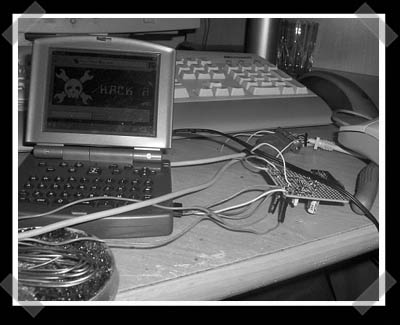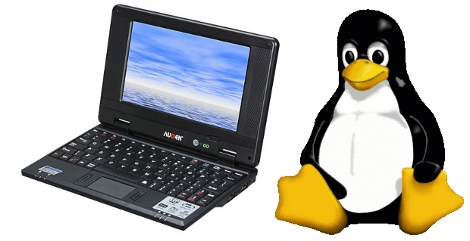
[karosium] sent in this one. He(?) put in alot of effort on this one. After flashing the EEPROM on the ZipIT he got the PIXIL embedded linux distro running on the ZipIT. It’s a work in progress, but the web browser works. Even if you don’t have a ZipIT, it’s worth checking out. There’s mention of building a PLCC32/DIP32 flasher built from an old PII. Great work!
Mini-SD And RS-232 Board For Zipit Wireless Messenger

Tom Walsh has been hard at work building an add on board for the Zipit Wireless Messenger “IM Device for Teens”. The board adds a mini-SD card slot, RS-232 (using a mini-USB connector) and a power supply for an EL backlight. I’m impressed that he got everything to fit inside of the case, very slick. A year ago we covered putting Linux on these devices. Have any of you readers picked up one and what fun tricks can it do? I looked around and they still cost over $90. I should probably just resurrect my Zaurus and be happy
HOWTO: Put Linux On A ZipIt Handheld

AiboHack of all places has come up with quite an interesting hack. Turns out someone actually can make good use of the $100 ZipIt Instant Messaging device. The ZipIt (in case you didn’t know) has built-in 802.11b WiFi, a really cheap 320×240 LCD screen, and the ability to IM with MSN, Yahoo!, and AOL Instant Messenger. Groovy, but what good is this to us if we don’t have a WiFi spot to use? Not much. So with a little tweaking and some re-flashing, you’ll be running a sub-2mb version of Linux in no time. Here’s what you’ll need:
-
A Zipit device you are willing to screw up
-
A Windows PC (Windows XP recommended)
-
A WiFi card, or WiFi access point, attached to the Windows PC
-
Optional: Linux PC or cygwin running on Windows PC (for compiling your own Linux ARM apps)
THP Entry: A Repurposed Luminiferous Aether Detector
 In the late 1800s, no one knew what light was. Everyone knew it behaved like a wave some of the time, but all waves need to travel through some propagation medium. This propagation medium was called the luminiferous aether and an attempt to detect and quantify this aether led to one of the coolest experimental setups of all time: the Michelson-Morely experiment. It was a huge interferometer mounted on a gigantic slab of marble floating in a pool of mercury. By rotating the interferometer, Michelson and Morely expected to see a small phase shift in the interferometer, both confirming the existence of a luminiferous aether and giving them how fast the Earth moved through this medium.
In the late 1800s, no one knew what light was. Everyone knew it behaved like a wave some of the time, but all waves need to travel through some propagation medium. This propagation medium was called the luminiferous aether and an attempt to detect and quantify this aether led to one of the coolest experimental setups of all time: the Michelson-Morely experiment. It was a huge interferometer mounted on a gigantic slab of marble floating in a pool of mercury. By rotating the interferometer, Michelson and Morely expected to see a small phase shift in the interferometer, both confirming the existence of a luminiferous aether and giving them how fast the Earth moved through this medium.
Of course, there was no phase shift, throwing physics into chaos for a few years. When [Beaglebreath] first learned about the Michelson-Morely interferometer he was amazed by the experimental setup. He’s built a few interferometers over the years, but for The Hackaday Prize, he’s making something useful out of one of these luminiferous aether detectors: a functional laser rangefinder capable of measuring distances of up to 60 inches with an error of 0.000005 inches.
The core of the system is an HP 5528A laser interferometer system. [Beaglebreath] has been collecting the individual components of this system off of eBay for several years now, and amazingly, he has all the parts. That’s dedication, right there. This laser interferometer system will be mounted to a simple camera slider, and with the interferometer measurements, humidity and temperature measurements, and some interesting code (running on one of these for hacker cred), [Beaglebreath] stands a good shot at measuring things very, very accurately.
The devil is in the details, and when you’re measuring things this precisely there are a lot of details. The original Michelson-Morely interferometer was affected by passing horse-drawn carriages and even distant lightning storms. While [Beaglebreath] isn’t using as long of a beam path as the OG interferometer, he’ll still have a lot of bugs to squash to bring this project to its full potential.
![]() The project featured in this post is an entry in The Hackaday Prize. Build something awesome and win a trip to space or hundreds of other prizes.
The project featured in this post is an entry in The Hackaday Prize. Build something awesome and win a trip to space or hundreds of other prizes.
Open Sourcing Everything… There’s An App For That

What happens if you’re a prolific developer and decide to release all of the source code from your work? Well, you should get a huge pat on the back from all interested parties. And so we say thank you to [Hunter Davis] for releasing the source code for his 70+ Android apps. But just making the decision isn’t the end of things, you’ve got actually get the code out there. And herein lies the hack. Instead of archiving and posting all of those projects he wrote a script to crawl, init, and push his projects to Github automatically.
This process is made pretty easy because of the Github API. Looks like he used version 2 for his script but you’ll want to check out version 3 if you’re looking to write your own script. His script takes the API key and username as command line arguments, then traverses his local source tree. Along the way it uses some text manipulation to sanitize the directories for use as the name of the repository. Once that’s established it steps into the directory, creates a repository, adds and commits all the files, then pushes them to Github.
Following [Hunter’s] example makes it really easy to share your code. We hope more will follow suit, putting their work out there for others to learn from and build upon.
We’ve seen some hardware hacks from [Hunter] as well. He did a bunch involving the ZipIt, as well as some work with playing games with a Dockstar.
[via Reddit]
Classic Game Emulation On The Dockstar

[Hunter Davis] is playing games like Contra, Monkey Island, and Quake 3 by running them on a Seagate Dockstar. We were shocked after seeing how well these run in the video after the break. [Hunter], who used the ZipIt for game emulation in the past, added a couple of hardware peripherals to get everything running. For sound he picked up an inexpensive USB sound card which was no problem to get up and running. Next he picked up a USB to DVI adapter and fired up the Linux USB DisplayLink driver. With the peripherals running he loaded up Fluxbox and the rest was history. Not bad for a small network storage adapter. Continue reading “Classic Game Emulation On The Dockstar”
Augen E-Go Booting Linux

The Augen E-Go is billed as a Netbook that ships with Windows CE. [Moogle] got it to boot the Linux kernel after a bit of hardware snooping. He found a UART connector on the main board and discovered that if you tie the enable pin to ground you can send an ARM bootloader to the device during boot up. His past experience hacking the Didj and the Explorer helped him recognize the processor used in the Augen. This lead to using a zimage from the Didj to boot the Linux kernel. So far the process halts at a kernel panic, but that’s because he hasn’t built the image with a file system for the device yet.
If the E-Go ends up playing nicely with Linux, [Moogle] may have found a suitable replacement for the Zipit.
Update: Looks like we’ve got the wrong version of the E-Go pictured above (and linked below). Check out [Moogle’s] comment for model numbers.
[Augen photo credit: Newegg.com]











